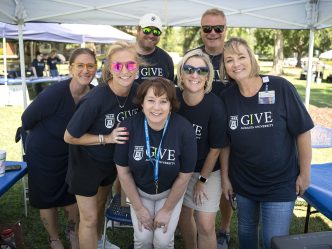As the end of the year approaches, many are beginning to turn their thoughts to 2019. Some may consider an exercise program as a way to start the New Year off on the right foot. Dr. Kevin Brueilly, chair of the Department of Physical Therapy at Augusta University, and Dr. Stephen Morris, president of the Academy of Oncologic Physical Therapy and distinguished professor at Wingate University, offer several tips for getting — and staying — in shape. The best part is that many of these tips can be implemented without the expense of joining a gym.
First, decide on a type of activity. The two types of exercise are aerobic, also known as cardio, and resistance, or strengthening exercises. For best results, incorporate both cardio and strength training into your workout routine.
“Something as simple as walking can be the most convenient aerobic activity, because it can be done almost anywhere and does not require special equipment,” Brueilly said. “Resistance training requires equipment often found at a gym. If the gym is not an option, you can buy dumbbells or household objects, food cans or bottles of fluid can make great weights.”
To begin, Brueilly suggests strengthening exercises without weights, just moving your arms or legs. This is also known as a body weight exercise.
Next, create goals for your exercise program. These should include target weight goals and activity goals. Write down these goals in a log book. Then, log activity during each exercise session, duration of exercise and exercise intensity.
“Starting and keeping such a notebook will help keep you accountable and provide you with a record of your progress,” Brueilly said.
Brueilly recommends that each exercise session consist of stretching exercises, the activity itself and a cool down.
Everyone’s exercise program is different. Brueilly offers the following tips to help you find your “stride:”
- Start slow and build up gradually.
- During aerobic activity, you should be able to talk without becoming short of breath.
- If you are sore from lifting weights you have done too much.
- Your ultimate goal should be 150 minutes of moderate exercise per week, but you should slowly work up to that goal.
- For aerobic exercise, ride a bicycle or row.
- Find something you can stick with. The “best exercise” is the one you will enjoy and keep doing.
- Consider “alternative” types of exercise, like dancing or yoga.
- Exercise with a friend. It keeps you both accountable.
- Monitor your progress.
- Build activity into your daily routine by looking for opportunities to move. Park your car further away from the building entrance, take the stairs or stand up during phone conversations.
- Remember, movement is exercise.
“Starting an exercise program is an important decision,” Brueilly said. “But it doesn’t have to be an overwhelming one. By planning carefully and pacing yourself, you can establish healthy habits that last a lifetime.
 Augusta University
Augusta University




